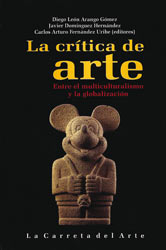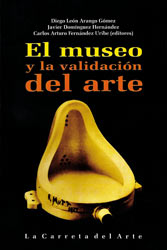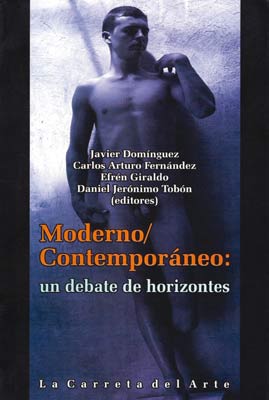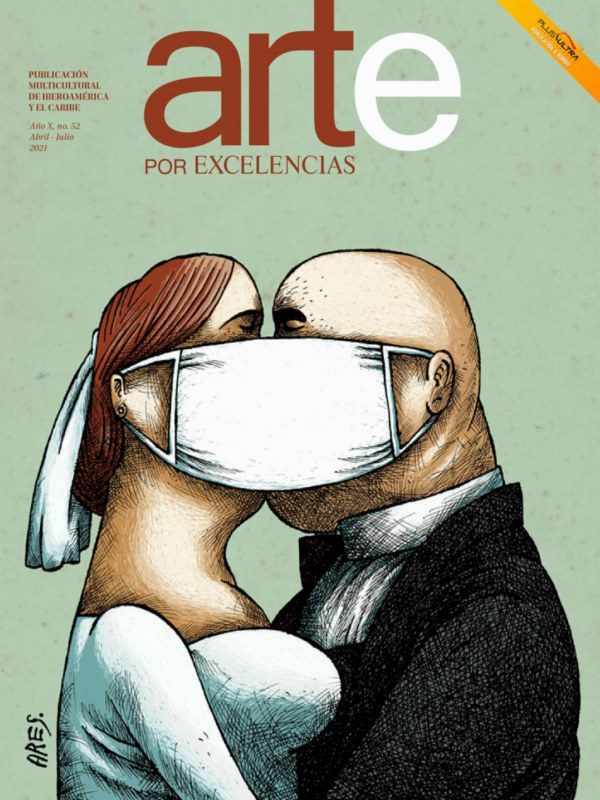There is no other attempt as thorny as that undertaken by theory to interpret current artistic practices. Devising a knowledge that can respond to the demands of those practices and at the same time can teach within tradition, the rupture of that tradition and continuity bonds, becomes a true act of magic full of skills hard to work out.
The critic apparatus around the Latin American art scenario goes from theoretical assumptions supported by the international art trend and the ways whereby its approaches, perspectives and lines of investigation are relocated. Then, how could it make its way through those straining forces delimited by geographical and cultural transference orders and multicultural process flowing between extraterritorial consensus and social flows? Forces that stamp out the imaginary, and create policies of cross-cultural representation that globalize the cultural diversity and make art rethink its social roles.
The Group of Theory and History of Art Research linked to the Arts Faculty of the University of Antioquia and the Institute of Philosophy was created in Medellin, Colombia, in 2001; also in that University, professors Carlos Arturo Fernandez Uribe and Javier Dominguez Hernandez had put forward, since 1996, the development of a national academic event that allowed the discussion of different topics related to theory and history of art. Thus, in the following year, the First National Seminar on Theory and History of Art was organized under the slogan “Art’s death.” The next one, held in 1998 under the topic “The image”; in 2000, it tackled the issue of “Art’s autonomy” and in 2002: “Art and its time.”1
Throughout all these years, a working process in tune with the research work, workshops, seminars and publications was developed in an effort to implement a thinking style and a scientific and teaching methodology. Up to the present, seven seminars have been carried out, and the three latest were published under the direction of Diego Leon Arango, Javier Dominguez and Carlos Arturo Fernandez.2
A peculiarity noticed in the group’s outcomes was the historical, theoretical tone of the working program, dictated by the interests of the benefitted subjects: history of art, aesthetic theory and art theory. They came together in the search for new forms giving shape to the artistic culture as a whole; on one hand, with the purpose of consolidating its disciplinary fields and on the other achieving an approach to the trans-discipline and pluralism that the expansion of the visual entails, to that complex string of the art world that has so many junctions established by the analytic of art or the showing off with ethics, politics and ideology.
Given the brevity of this space, I will refer to seminars 5, 6 and 7 (2004, 2006 and 2008 respectively) and to the three books, maintaining the title of each encounter, published in 2008: Art critique: between multiculturalism and globalization; The museum and validation of art, and Modern/Contemporary: a debate on horizons, three interconnected fields that offer many possibilities to discover the links between theory and artistic practice from the perspective of critic language, the art institution and a denomination that pretends to be its essential classification. Looking at them all together helps to understand the group’s research interests. Is there a better presentation of a thinking style than the guidelines of its research? It’s like a puzzle that seeks for good answers if good questions are asked.
 The book summarizing the 2004 meeting (Art critique: between multiculturalism and globalization) starts with a presentation of the objective of the space and the possibilities it offered for the analysis of the topic. It states: “Art critique’s statute and objective are matters that should be constantly redefined; both of them depend on dynamics and inertias in which other transformations occur: those related to concept and representations of art and its historiography, to museum and its bonds with the audience, conception and mobility of exhibitions” (ibid, 7). Thus, it draws a reflexive line that is extended to the subsequent seminars addressing the art world from different perspectives.
The book summarizing the 2004 meeting (Art critique: between multiculturalism and globalization) starts with a presentation of the objective of the space and the possibilities it offered for the analysis of the topic. It states: “Art critique’s statute and objective are matters that should be constantly redefined; both of them depend on dynamics and inertias in which other transformations occur: those related to concept and representations of art and its historiography, to museum and its bonds with the audience, conception and mobility of exhibitions” (ibid, 7). Thus, it draws a reflexive line that is extended to the subsequent seminars addressing the art world from different perspectives.
The event was divided into two parts: one represented by the topic “One current image of art critique,” developed in nine papers that served as focal points for the discussions, and the other one, conceived as communications under the slogan “Localized art critique practices,” analyzed in ten presentations. In the presentation in the book, we find an interesting quote: “In both parts we alternated articles about theory and praxis. It is a working criterion that we share as both aspects that need one another” (ibid, 9).
This bond is an essential part of the working program; it is also present in the views on critique based on the double tension stemming from the multicultural and the global, since the interest is not built on traditional points of view about its role in the art world, but on its current, most pressing circumstances from which its functions acquire social and cultural dimensions, together with a language necessarily taken from other fields of knowledge: “The ideal of the critique would be to put into practice, at least in the art world, what knowing how to live in pluralism entails, the optimum sociability hindered by globalization” (ibid, 8).
 The sixth seminar (The museum and validation of art), as we already noted, focused on the always-questionable field of museums. In the presentation, it is stated: “The interest guiding this conversation lay on both the issue of art validation at present, what defines it or not as art […] and the situation of museums within such process.”
The sixth seminar (The museum and validation of art), as we already noted, focused on the always-questionable field of museums. In the presentation, it is stated: “The interest guiding this conversation lay on both the issue of art validation at present, what defines it or not as art […] and the situation of museums within such process.”
Both aspects when interconnected offer the possibility of a panorama that is closer to the reality of art, always waiting for legitimizing authorities. That’s why, some of the papers didn’t referred to this aspect but to the mutual forms whereby the exchange with the audience, artists and the museum create possibilities that a relationship emerges among them: “in a wide range going from the artists’ appropriation of museums and exhibition halls as a topic and tool for artistic creation to the museum’s constant efforts to generate new relationships with the audience” (ibid, 8).
Once this level of the critic expression was reached, it was very thoughtful the idea of dedicating a seminar to the discussion of temporary and theoretical frameworks that set the limits and establish the concept of art from the perspective of its classification as modern or contemporary.
The presentation of the book summarizing the papers given at the seventh seminar (Modern/Contemporary: a debate on horizons) states: “What makes a work of art of these days ‘contemporary’? Is this question applicable? Does this mean that the concept of ‘contemporary’ is already a historiographic concept (like that of Baroque or Renaissance) that includes methodological implications? If that were the case, could we talk about the characteristics of the ‘contemporary’? Is the term ‘contemporary’ more flexible and useful than the term ‘postmodern’ to characterize whatever that goes beyond modernity?” (ibid, 7)
Consistent with these criteria, the presentations dealt with different patterns of the modern as contemporary, the history of art as post-history, contemporary-culture art and internationalization, how the concept of contemporary has operated in the art critique in Colombia, parodic identities and contextual meddling in contemporary art, along with a group of debates related to generic types like video art or installations.
 Professor Carlos Alberto Ospina’s3 presentation sums up the features of modernity that “highlight seven signs of contemporary art.” A clever description that ties the modern, the postmodern and the contemporary in a game of historical and logical tensions, promoting the main purpose of the event that is to reach “a discussion that go beyond a simple contraposition of denominations” (ibid, 7).
Professor Carlos Alberto Ospina’s3 presentation sums up the features of modernity that “highlight seven signs of contemporary art.” A clever description that ties the modern, the postmodern and the contemporary in a game of historical and logical tensions, promoting the main purpose of the event that is to reach “a discussion that go beyond a simple contraposition of denominations” (ibid, 7).
Reviewing the book compiling the papers makes it possible to have a tempting notion of the topic, taking into account the multidiscipline cross of the speakers and the diverse character of the approaches that facilitate that perspective.
What do these encounters legitimize? What theories do they strengthen? It’s hard to answer these questions in a single direction, since all “the geometric expansion of art practices and critique,” “the multiplicity of cultural and artistic players,” or “the global contemporary immensity”4 boost a panorama in which, day by day, local and global threads are rearranged in terms of both art’s institutional bonds and theoretical frameworks that define what is art or what isn’t.
The cultural means whereby the Colombian art develops is very suggestive due to the diversity of artistic forms and themes it features. That’s why it is encouraging to see the efforts of a group of experts trying to go deeper into a series of topics related to artistic creation, covering pluralism, the multicultural and fluctuations between the global and the fragmentary.
We’ll wait then for future encounters and the excellent possibility of living them through the publications, which will allow us to feel, at distance, their passions and emotions, as a lover waiting for the next rendezvous..
La crítica de arte: entre el multiculturalismo y la globalización; El museo y la validación del arte, y Moderno/Contemporáneo: un debate de horizontes: Diego León Arango Gómez, Javier Domínguez Hernández y Carlos Arturo Fernández Uribe, editores, La Carreta Editores, Facultad de Artes, Instituto de Filosofía, Universidad de Antioquia, Antioquia, 2008.
Notes
1 The written papers of seminars 1, 2 and 3 were published by Estudios de Filosofia, Institute of Philosophy, n. 13 (1998), 15-16 (2000), 21-22 (2002), University of Antioquia, Medellin respectively. See indexes at:
http://docencia.udea.edu.co/revistafilosofia/numeros/pdf/indice13.pdf; http://docencia.udea.edu.co/revistafilosofia/numeros/pdf/indice1516.pdf,and http://docencia.udea.edu.co/revistafilosofia/numeros/pdf/indice%2021-22.pdf. The written papers of the fourth seminar were published by Artes la Revista, Arts Faculty, n. 6 and 7, University of Antioquia, Medellin, 2004). The full texts can be downloaded from:
http://dialnet.unirioja.es/servlet/listaarticulos?tipo_busqueda=EJEMPLAR&revista_busqueda=6527&clave_busqueda=113606
2 Among international specialists invited to the different editions of the seminars were: Anna Maria Guasch, Katia Hanza, Vicente Jarque, Gerardo Mosquera, Kevin Power and Magaly Espinosa.
3 “Modern-contemporary. From the illusion of the real to the reality of fiction,” in ob. cit., pp. 276-278.
4 Gerardo Mosquera: “From here: Contemporary Art, culture and internationalization,” in ob. cit., p. 111-113.
Related Publications

How Harumi Yamaguchi invented the modern woman in Japan
March 16, 2022












